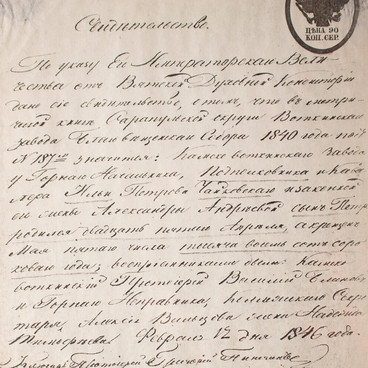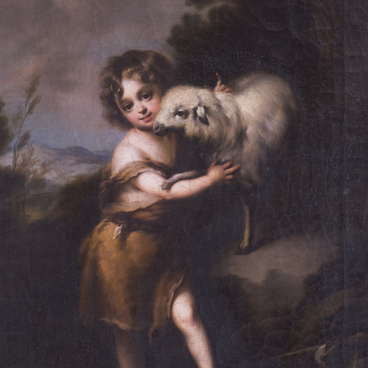The work ‘Saint John the Evangelist’ by an unknown 19th-century artist was transferred to the Museum Estate in December 1968 from the Pavlovsk Palace. Researchers believe this canvas is a reproduction of a painting by Florentine artist Carlo Dolci.
Carlo Dolci was born on May 25, 1616 in Florence. He was sent at a young age to study at the art school of master Jacopo Vignali. Dolci was known for his piety and created many works on religious subjects. His contemporaries noted that he traditionally painted a new image of Christ with a crown of thorns every Easter.
Dolci worked neatly and rather slowly, conceptualizing and painting the smallest details. Luca Giordano, a painter known for his speed, who was nicknamed Luca Fa-Presto (quick worker), advised Dolci to paint faster otherwise, he said, Dolci could starve to death. As an illustrative example, Giordano painted more in five hours than Dolci did in several months of work. After this, Dolci fell into despair and was depressed until the last day of his life. When the master was old, his daughter Agnese helped him work on his paintings.
At the end of the 18th century, Dolci’s paintings were very popular among noble art connoisseurs, who brought many of his works to Europe.
The image of John the Evangelist appears repeatedly in Dolci’s paintings, especially in his early period. The Holy Apostle and Evangelist John occupied a special place among the disciples of Jesus Christ: he was one of his favorites. John followed Christ when he was betrayed by Judas and was led out of the Garden of Gethsemane for trial.
According to the Christian tradition, after the Assumption of the Mother of God, Apostle John traveled to Ephesus, Patmos, and other towns of Asia Minor to preach the Gospel. It is believed that John the Evangelist is the author of the Gospel of John, the Book of Revelation, and three epistles that are part of the New Testament.
In this canvas, the artist painted John the Evangelist writing the Gospel. The apostle is depicted as a gentle young man. He holds a quill in his right hand and an open book in his left, and is dressed in a dark green chiton and a bright red cloak. His long hair falls down over his shoulders. The contrasting dark background creates an unusual effect: it seems as if a slight glow emanates from John’s luminous face.
Carlo Dolci was born on May 25, 1616 in Florence. He was sent at a young age to study at the art school of master Jacopo Vignali. Dolci was known for his piety and created many works on religious subjects. His contemporaries noted that he traditionally painted a new image of Christ with a crown of thorns every Easter.
Dolci worked neatly and rather slowly, conceptualizing and painting the smallest details. Luca Giordano, a painter known for his speed, who was nicknamed Luca Fa-Presto (quick worker), advised Dolci to paint faster otherwise, he said, Dolci could starve to death. As an illustrative example, Giordano painted more in five hours than Dolci did in several months of work. After this, Dolci fell into despair and was depressed until the last day of his life. When the master was old, his daughter Agnese helped him work on his paintings.
At the end of the 18th century, Dolci’s paintings were very popular among noble art connoisseurs, who brought many of his works to Europe.
The image of John the Evangelist appears repeatedly in Dolci’s paintings, especially in his early period. The Holy Apostle and Evangelist John occupied a special place among the disciples of Jesus Christ: he was one of his favorites. John followed Christ when he was betrayed by Judas and was led out of the Garden of Gethsemane for trial.
According to the Christian tradition, after the Assumption of the Mother of God, Apostle John traveled to Ephesus, Patmos, and other towns of Asia Minor to preach the Gospel. It is believed that John the Evangelist is the author of the Gospel of John, the Book of Revelation, and three epistles that are part of the New Testament.
In this canvas, the artist painted John the Evangelist writing the Gospel. The apostle is depicted as a gentle young man. He holds a quill in his right hand and an open book in his left, and is dressed in a dark green chiton and a bright red cloak. His long hair falls down over his shoulders. The contrasting dark background creates an unusual effect: it seems as if a slight glow emanates from John’s luminous face.



